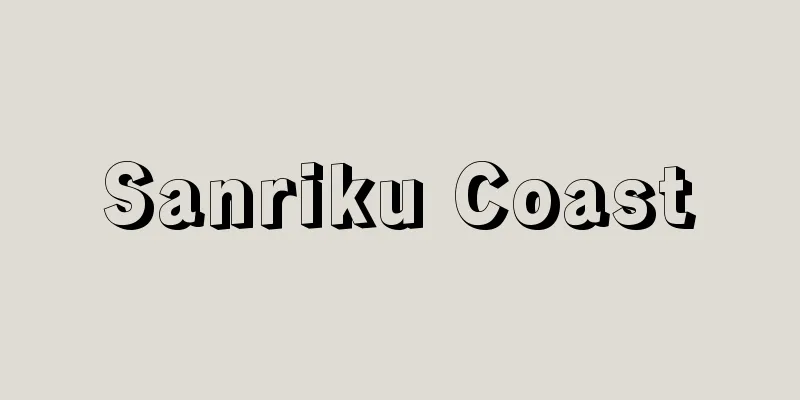Sanriku Coast

|
The coastline stretches from Samekado in Hachinohe City, Aomori Prefecture to the Oshika Peninsula in Miyagi Prefecture. It is a long coastline of about 600 km, and is called the Sanriku Coast because it spans the three provinces of Mutsu, Rikuchu, and Rikuzen. The eastern edge of the Kitakami Highlands juts out into the Pacific Ocean in an arch-like shape, and the coast north of Miyako City is an uplifted coast with marine terraces and many cliffs and precipices. Small fishing ports are dotted at the mouths of rivers that flow into the gaps, creating canyons between them. In contrast, the coast south of Miyako is a submerged coast with many alternating bays and capes, and is blessed with good natural ports. The coast is designated as Sanriku Fukko National Park (formerly Rikuchu Kaigan National Park and formerly Minamisanriku Kinkazan Quasi-National Park). The offshore area is a good fishing ground for whales, tuna, swordfish, bonito, saury, squid, and sardines, while the coast is a thriving abalone, wakame seaweed, and sea urchin farm, with Miyako, Kamaishi, Kesennuma, and Onagawa being some of the fishing ports with the highest landings in the country. There are also a number of coastal industries, including steel in Kamaishi, industrial chemicals and gypsum in Miyako, and cement in Ofunato. The Sanriku Railway (which began operations in 1984) Rias Line runs through the area, and National Route 45 runs parallel to the railway. This area has suffered damage from large tsunamis caused by earthquakes many times. Since the Chilean earthquake and tsunami in 1960 (Showa 35), disaster prevention measures such as building seawalls have been taken, but the damage caused by the Great East Japan Earthquake in 2011 (Heisei 22) was enormous. Currently, in addition to the seawalls, measures such as relocating residents to higher ground and raising the current land level are being taken. [Tadashi Kawamoto] [References] | |Source: Shogakukan Encyclopedia Nipponica About Encyclopedia Nipponica Information | Legend |
|
青森県八戸(はちのへ)市鮫角(さめかど)から宮城県牡鹿(おしか)半島に至る海岸線。約600キロメートルの長大な海岸で、陸奥(むつ)、陸中(りくちゅう)、陸前の3国にまたがることから三陸海岸とよばれる。北上(きたかみ)高地東縁が弓なりに太平洋に張り出した海岸で、宮古市(みやこし)を境に北は隆起海岸で海成段丘が発達し、断崖(だんがい)、絶壁が多く、その間隙(かんげき)を縫うように峡谷をつくりながら注ぐ河川の河口に小漁港が点在する。これと対照的に宮古以南は沈降海岸で多くの湾入と岬とが交互に連続し、天然の良港に恵まれている。海岸は三陸復興国立公園(旧、陸中海岸国立公園および旧、南三陸金華山国定公園)に指定されている。 沖合いはクジラ、マグロ、カジキ、カツオ、サンマ、イカ、イワシなどの好漁場であり、沿岸はアワビ、ワカメ、ウニなどの養殖が盛んで、宮古、釜石(かまいし)、気仙沼(けせんぬま)、女川(おながわ)などは全国屈指の水揚高を誇る漁港である。また、釜石市の製鉄、宮古市の工業薬品や石膏(せっこう)、大船渡(おおふなと)市のセメントなど臨海工業の集積がみられる。三陸鉄道(1984年営業開始)リアス線が通じる。また鉄道に並行して国道45号が走っている。 当地域は何度も地震による大津波の被害を受けてきた。1960年(昭和35)のチリ地震津波以降、防潮堤を築くなどの防災対策がとられてきたが、2011年(平成22)の東日本大震災における被害は甚大であった。現在は防潮堤に加え、住民の高台移転、現地嵩(かさ)上げなどの対策がとられている。 [川本忠平] [参照項目] | |出典 小学館 日本大百科全書(ニッポニカ)日本大百科全書(ニッポニカ)について 情報 | 凡例 |
>>: Sanriku offshore earthquake
Recommend
Indische Vereeniging (English spelling)
…An organization of Indonesian students who engag...
May Day Incident
On May 1, 1952 (Showa 27), the 23rd May Day, poli...
Uracil
...In DNA, the sugar moiety is 2-deoxy-D-ribose, ...
Niijima
An active volcanic island in the Izu Islands. It ...
Griffith flaw (English spelling) Griffithflaw
...This refers to plate glass that has been therm...
Nagachika Kanamori
A military commander in the Azuchi-Momoyama perio...
Governor - Kokushi
A general term for local officials who were dispa...
seismonasty
…a property of plant organs bending in response t...
Heir of Kazusa
…During the Ten'yō era (1144-45), he allied w...
Boulton & Watt Company - Boulton & Watt Company
The world's first steam engine manufacturing c...
Bregmaceros japonicus
A marine fish of the family Cordiformes and family...
Mictyris livingstoni (English spelling) Mictyris livingstoni
… [Takeda Masatomo]. … *Some of the terminology t...
Pheretial earthworm (large earthworm) - Pheretial earthworm
A general term for annelids belonging to the famil...
Payment judgment - Verurteilungsurteil, Leistungsurteil
When a lawsuit for performance is filed, a judgmen...
Jacob Cornelisz. van Neck
1564‐1638 Admiral of the Dutch East Indies expedit...









